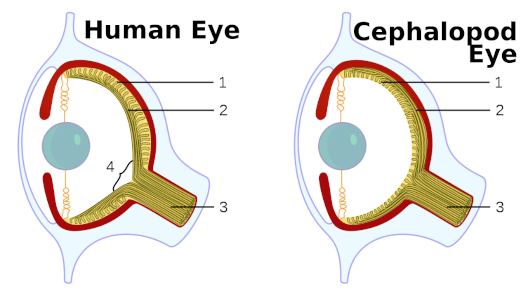The Eye of an Octopus
Genesis 1:20
“And God said, Let the waters bring forth abundantly the moving creature that hath life, and fowl that may fly above the earth in the open firmament of heaven.”
 The eye is a very complex organ. A vertebrate eye, such as that possessed by humans, contains a number of separate parts, all of which have to work together. It is easy, therefore, to show that an eye could not have evolved. Our eyes contain a lens, which is transparent and convex, like the lens of a camera. But, unlike the camera lens, the eye lens can have its focal length altered by being stretched thinner, or squashed fatter, by tiny muscles. If the lens had evolved without the muscles, it would have been useless. The lens needs to focus light on to the retina, where the photo-receptors are found. The retina would have been useless if it had evolved with no lens, and there would be no evolutionary advantage to an organism with a lens, but no retina. And none of these features are useful without a nerve to take the signals of these images to the brain.
The eye is a very complex organ. A vertebrate eye, such as that possessed by humans, contains a number of separate parts, all of which have to work together. It is easy, therefore, to show that an eye could not have evolved. Our eyes contain a lens, which is transparent and convex, like the lens of a camera. But, unlike the camera lens, the eye lens can have its focal length altered by being stretched thinner, or squashed fatter, by tiny muscles. If the lens had evolved without the muscles, it would have been useless. The lens needs to focus light on to the retina, where the photo-receptors are found. The retina would have been useless if it had evolved with no lens, and there would be no evolutionary advantage to an organism with a lens, but no retina. And none of these features are useful without a nerve to take the signals of these images to the brain.
A further blow that the eye gives to evolution is when we examine the eyes of cephalopods, like the octopus. The eyes of these mollusks are pretty much the same as vertebrate eyes. Are we expected to believe that they evolved separately to the same design? Cephalopods are supposedly less evolved than humans. Yet their eyes seem to be more advanced, as they do not possess the blind spot of the vertebrate eye.
None of these issues is difficult to understand when we realize that these features were designed by God, just as He said.
Prayer: Thank You, Father, for the gift of sight. Thank You for making our eyes as such a miraculous design which points to You and Your creative power. Amen.
Author: Paul F. Taylor
Ref: Encyclopedia Britannica, < https://www.britannica.com/science/photoreception/Central-processing-of-visual-information >, accessed 1/31/2019. Image: CC BY-SA 3.0 Unported.
© 2020 Creation Moments All rights reserved.